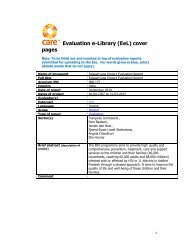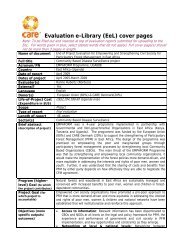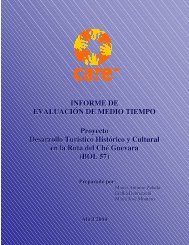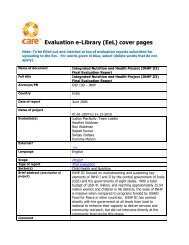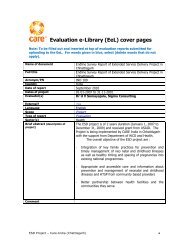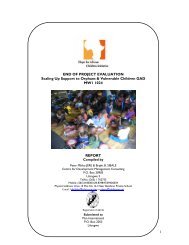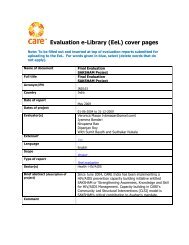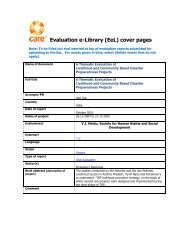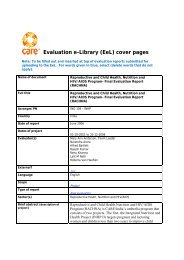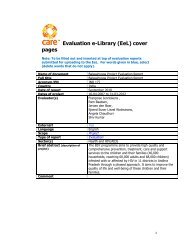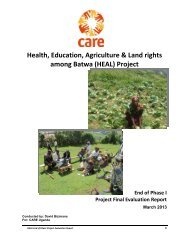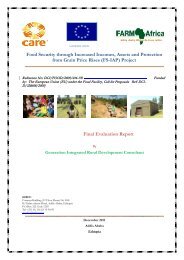IND 199 ECDE Baseline - CARE International's Electronic ...
IND 199 ECDE Baseline - CARE International's Electronic ...
IND 199 ECDE Baseline - CARE International's Electronic ...
- No tags were found...
You also want an ePaper? Increase the reach of your titles
YUMPU automatically turns print PDFs into web optimized ePapers that Google loves.
xlv• Mostly father provides help in giving bath to the child and in eating the child. The otherkind of helps provided by father are: dressing the child, making the child learn and playingwith the child.• On an average , they spend more than 1½ hours in a day to take care of the child5.1.4 Activities undertaken to develop different sensesAll the surveyed mothers / caregivers of children aged 3-3.5 years were asked what kind ofactivities they do to develop child’s ability with regard to sight, smell, sense, taste and touch..The following findings have emerged from Table 5.4A in Annexure -2.• Mostly they show different birds , animals , fruits , vegetables and various other things todevelop their child’s ability for sight• For smell, they mostly ask the child to see various things such as flowers, agarbeti , mud,garlic , medicine etc. and ask how the child feels after smelling.• For sense , they mostly ask the child how he/she feels about “Marne se ehsaas hota hai” ,“ant/ mosquito katne ka ehsaas hota hai”, “Uchaiya se girne se ehseas hota hai” , “Chuneka ehsaas hota hai etc.• The respondents reported to provide different things and ask the child to eat to develophis / her taste. For this they give food, fruit , sweet , gur , salt , tea medicine , kheer etc.and ask the child how he/she feels after eating.• For touch they mostly stated “subhe chune se uth jaata hai” , “sone ka bad chune se uthjata hai”, “chune se apni aur dekhta hai” , “Ek dusare ko hath laga kar” , “chune kaehsaas” etc.63 5.2 Status of development of children aged 3-3.5 yearsAll the surveyed mothers/ caregivers of children aged 3-3.5 yeas were asked a series ofquestions related behavioral and development aspects whether their child had achieved or not.5.2.1 Behavioral aspectsUnder behavioral aspects , five questions were asked from mothers / caregivers whether theirchild (i) asks to many questions, (ii) is curious to know about body parts, (iii) likes to do thingshimself / herself , (iv) feels jealous, if a younger baby comes in the family, being afraid ofreduction in love and affection he /she was getting and (v) starts recognizing genderdifferences and correctly says “I am a boy or girl”. Table 5.4 provides their responses.• More than four – fifths of the respondents replied in affirmative for questions (i), (ii) and(v). About 68 percent of the respondents in intervention districts and 84 percent in controldistrict reported that their child liked to do things himself / herself , while about two –fifths in intervention districts and 47 percent in control district expressed that their child“feels jealous if a younger baby comes in the family , being afraid of reduction in love andaffection he/she was getting”Table 5.4: Development status of the child aged 3-3.5 years on behavioral aspects(Percentage)Intervention districts Control districtBehavioralIntervention Intermediate Control<strong>Baseline</strong> Study Of Early Childhood Care And Development Project In ChattisgarhApril,2012



